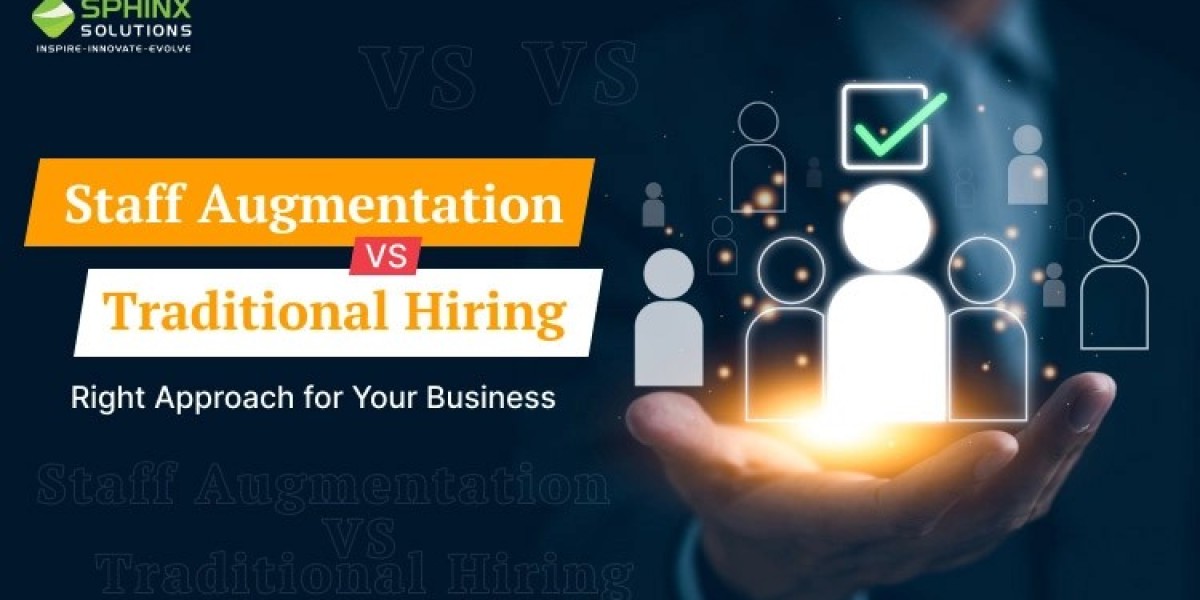In today’s fast-paced business environment, companies are under growing pressure to stay agile and responsive to shifting market demands. One key decision in managing talent is whether to opt for staff augmentation services or traditional hiring. Both approaches offer distinct advantages and challenges, making it crucial to understand which strategy best fits your company’s needs.
Understanding Staff Augmentation Services & Traditional Hiring
This blog delves into the complications of staff augmentation services and traditional hiring, providing a comprehensive comparison to help you make an informed decision that supports your business growth. According to the survey report conducted among staff and recruitment professionals by Statista, almost half of the respondents expected an increase in operating budget and technology investments.
Companies must decide how to bring new talent on board based on their project and operational needs. In this blog, we’ll explore two prevalent approaches staff augmentation, which involves integrating temporary or external personnel to support the existing team, and traditional hiring, which entails recruiting full-time or part-time employees directly under the employer’s organization.
Staff Augmentation Services:
It is a staffing model in which a brand hires contract workers to meet project requirements. These contract workers collaborate with the company’s internal team for a specified duration, bringing specialized skills and expertise to particular projects.
Benefits
- Greater Flexibility: Brands are increasingly engaging top-tier professionals on a contract basis, tailored to specific projects and requirements. This approach provides the flexibility to scale their workforce rapidly in response to evolving business demands.
- Hiring Talents: Drawing from previous projects or the specific skills individuals have, companies tap into specialized expertise without the need for permanent hires. This approach allows access to experts in particular fields while avoiding the commitment of permanent employment.
- Cost-Efficient: This approach enables companies to manage expenses effectively by adjusting the workforce based on current needs. By hiring professionals on a project basis, companies avoid long-term costs, such as salaries, benefits, and other employee-related expenses.
Elevate your projects with expert staff.
Traditional Hiring:
Traditional hiring involves bringing permanent employees onto the company’s payroll, on a full-time basis. These employees are hired to fulfill specific roles within the organization and are anticipated to stay at their positions for the long term. This approach fosters stability and continuity, contributing to a consistent workforce that aligns with the company’s long-term goal.
Benefits
- Commitment and loyalty: Traditional hiring fosters a strong sense of commitment and loyalty among employees, as they become integral members of the company. This long-term relationship leads to greater engagement, dedication, and alignment with the organization’s goals and values.
- Opportunities to Grow: This provides employees with clear pathways for professional development and career advancement within the organization. This structure encourages long-term growth, enabling employees to build their skills and progress in their roles while contributing to the company’s success.
- Organization Culture: This helps in cultivating and maintaining a cohesive organizational culture. Permanent employees, who are deeply integrated into the company, contribute to and reinforce the company’s values, norms, and work environment, fostering a strong sense of community and shared purpose.
Differences in Payroll and Legal Implications: Traditional Hiring vs Staff Augmentation Services
When differentiating between staff augmentation services and traditional hiring, there are key differences in payroll and legal implications. Traditional hiring places full payroll and legal responsibilities on the company, including direct management of employee benefits and compliance with labor law However, Staff augmentation services often involve paying contractors through third-party agencies and shifting administrative and legal responsibilities to those agencies. Here are certain points to be considered:
Payroll Differences
Traditional Hiring:
- Payroll Hierarchy: Employees are directly on the company’s payroll, receiving regular salaries or hourly wages every given time. This includes ongoing compensation commitments.
- Enhancing Stability: Payroll expenses are fixed and predictable, providing stability in budgeting but requiring long-term financial commitment.
- Responsible Administrative: The brand or organization handles all aspects of payroll, including withholding taxes, managing benefits, and ensuring compliance with employment laws.
Need top talent? Discover how Sphinx Solutions can boost your team.
Staff Augmentation:
- Structure Of Payment: Employers receive payment through a third-party agency or contract service, with the company only covering the cost of services based on an hourly rate or project basis
- Core Flexibility: Companies are aligned to adjust the costs based on the current demand for temporary or contract workers. Payroll expenses are variable and closely aligned with project needs.
- Administrative Pressure: The responsibility for payroll management, including taxes and benefits, generally falls on the contractor, reducing the company’s administrative load.
Traditional Hiring | Staff Augmentation Services |
Payroll Hierarchy | Structure Of Payment |
Enhancing Stability | Core Flexibility |
Responsible Administrative | Administrative Pressure |
Legal Implications
Traditional Hiring:
- Employment Classification: Rights associated with the protections under the employment law, employees are classified as regular, full-time, or part-time.
- Liability: The brand owns full responsibility for legal issues related to employment, including compliance with workplace safety, labor law, and employee rights.
- Compliance: Companies are required to comply with various employment regulations, such as minimum wage laws, anti-discrimination rules, and workplace safety standards.
Staff Augmentation Services:
- Employment Classification: Staff augmentation usually involves independent contractors or temporary workers who are not considered employees of the company. This arrangement can impact their access to benefits, job security, and other employment rights.
- Liability: Legal responsibilities for worker-related issues, including workers’ compensation and unemployment insurance, are generally assumed by the staffing agency or contractor service.
- Compliance: Companies must ensure that their use of staff augmentation adheres to labor laws, including regulations on contractor classification and workplace safety.
Traditional Hiring | Staff Augmentation Services |
Employment Classification | Employment Classification |
Liability | Liability |
Compliance | Compliance |
Factors Involved in Implementing Staff Augmentation Services and Traditional Hiring
Staff Augmentation Services
Challenges:
- Complex Integration:
- Problem: Temporary or contract workers may struggle to integrate with the existing team and company culture.
- Solution: Facilitate smooth onboarding processes and provide clear communication to help temporary staff acclimate quickly.
- Transfer of Knowledge:
- Problem: Short-term workers may not fully understand or retain knowledge about company processes and systems.
- Solution: Implement thorough documentation and handover procedures to ensure essential information is shared effectively.
- Legal Issues:
- Problem: Misclassification of workers or improper handling of legal responsibilities leads to compliance issues.
- Solution: Work closely with staffing agencies to ensure compliance with labor laws and contractor classification standards.
Elevate your projects with expert staff.
Traditional Hiring
Challenges:
- High Budget:
- Problem: Permanent hires incur higher long-term costs, including salaries, benefits, and training expenses.
- Solution: Conduct a thorough cost-benefit analysis to ensure the investment aligns with long-term business goals and budget constraints.
- Time-taking Recruitment:
- Problem: The process of hiring and onboarding permanent employees tends to be time-consuming and complex.
- Solution: Streamline recruitment and onboarding processes using efficient tools and clear procedures to expedite hiring.
- Retention of Employee:
- Problem: The process of hiring and onboarding permanent employees tends to be time-consuming and complex.
- Solution: Streamline recruitment and onboarding processes using efficient tools and clear procedures to expedite hiring.
Top Companies That Offer Staff Augmented Services in 2024
Sphinx Solutions: Sphinx Solutions stands out for its tailored staff augmentation services, delivering highly skilled professionals to meet specific client needs. They offer extensive tech expertise and ensure seamless team integration with a focus on quality and adaptability. Their rigorous candidate selection and client-focused approach make them a top choice for personalized staffing solutions.
Technologies:
- Web Development: Proficient in modern web technologies including Angular, React, Vue.js, and Node.js for creating scalable and responsive web applications.
- Cloud Computing: Experienced in cloud platforms such as AWS, Azure, and Google Cloud, providing scalable solutions and cloud-native application development.
Features
- Flexible Engagement Models: Various engagement models including contract-based, project-based, and on-demand staffing to suit different business needs.
- Client-Centric Approach: Focus on understanding client requirements and providing dedicated support to ensure successful project outcomes.
Toptal: Toptal connects businesses with elite freelance talent across various fields. They are known for their thorough vetting process and flexibility in providing short-term and project-based expertise. This makes Toptal an excellent option for companies seeking specialized skills for specific projects.
Robert Half: Robert Half specializes in staff augmentation for technology, finance, and other sectors. They leverage a broad talent network and efficient placement processes to support companies in integrating skilled professionals into their teams quickly and effectively.
Adecco: Adecco offers versatile staffing solutions, including staff augmentation, across numerous industries. Their global presence and focus on matching candidates to project needs help businesses manage workforce requirements with reliability and flexibility.
Kelly Services: Kelly Services provides staff augmentation by tapping into a wide talent pool for various sectors. They emphasize rapid placement and quality service, catering to companies in need of temporary or project-specific staffing solutions.
Need top talent? Discover how Sphinx Solutions can boost your team.
Conclusion
Choosing between staff augmentation services and traditional hiring is a strategic decision that depends on your company’s goals, and resources. Staff augmentation services offer flexibility and specialized skills for short-term needs, while traditional hiring provides stability and long-term commitment. By carefully assessing your business’s financial considerations and growth projections, you can select the approach that best aligns with your strategic objectives.
FAQ’s
1. What is the difference between staff augmentation services and traditional hiring?
Staff augmentation services involve bringing in temporary or contract professionals to complement the existing team and address specific project needs, offering flexibility in staffing. However, traditional hiring integrates permanent employees into the company’s workforce, resulting in long-term employment and stability.
2. What is a staff augmentation service?
Staff augmentation service is a staffing strategy where companies engage temporary or contract workers to fill specific roles or gaps in expertise for a defined period. This approach allows businesses to quickly access specialized skills and adjust their workforce based on project requirements without the long-term commitment of permanent hires.
3. What are the benefits of staff augmentation Services?
Staff augmentation service provides the advantage of flexibility, allowing companies to scale their workforce up or down based on current project needs. It also grants access to specialized skills without the long-term financial commitment of full-time employees.








